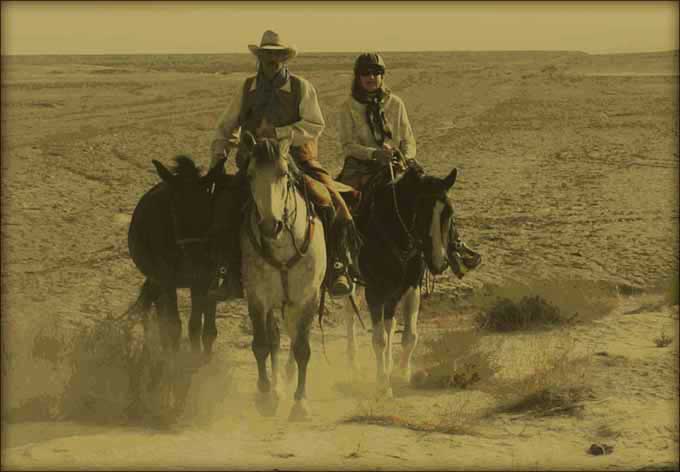"Winnie walking across America"
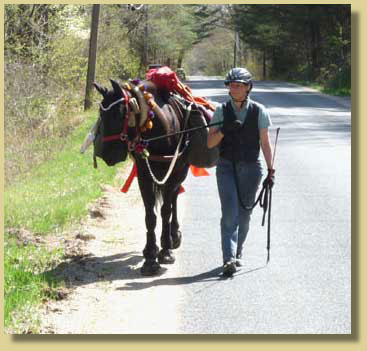
Winnie & Anne walking down a country road.
Why Walk...
Moving to Massachusetts -- a place 3000 miles from home in California -- puts a big dilemma before me. What about my little mustang, Winnie? I made a commitment to her when I adopted her. She is the rescue horse that rescued me, giving me a reason to get up every morning, during the worst phase of the business spiral down. I haven’t the money to trailer her anyway.
Of course she must be prepared for the trip, and she must be the right horse for the job. When a person bonds with a horse, they learn about that horse’s unique qualities and characteristics, they come to understand that horse in a special way. I believe Winnie can go the distance.
Winnie is also right for the job because she’s a quiet horse. She doesn’t spook at dogs, cats, cows, moose in the woods, logging trucks, cherry pickers, school buses, low-flying airplanes, trains, bikes, tractors, umbrellas, skateboards, balloons or kids playing basketball. She easily finds her way past all obstacles in the woods, although I admit, water crossings present some challenge. Don’t forget, she’s from the Nevada desert. Not many rivers out there!
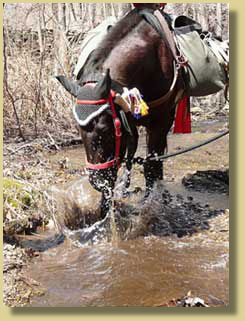
Winnie taking a drink.
Winnie and I want to walk for several reasons. One thing we hope to do is to prove the value of the American Mustang, and to encourage continued protection for each animal, whether or not that horse remains in the wild or is put to good use by a loving owner.
When others argue that it is costing too much to try and save the mustangs, let’s remember that their ancestors were brought here by settlers and they worked hard to prove their worth. Those horses blazed our trails, helped us plough our fields and grow our greens, logged trees to build our shelters, helped us communicate with one another via pony express, transported us from one place to another, and bravely accompanied us into battle and died in our wars.
These sturdy horses still have value today, not only as sport horses, pleasure horses, and work horses, but as horses that can save lives. I’m not referring to mountain rescue only, but to those mustangs who transform lives, like those in the prison program, or those who become therapy horses for the disabled, or those who rescue owners like me from hopelessness and doubt.
Winnie taught me so many things during our training sessions, especially patience. She’s always been honest about how she feels about things, and she required that I be honest with her, too. I soon learned that it was all about trust and that her trust had to be earned, and once I had that, she would do most anything for me.
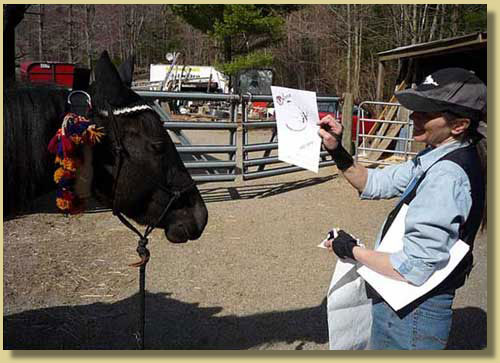
Winnie's autograph
Winnie taught me about coping with fear and facing those things we fear the most. She taught me to find my freedom within the boundaries of responsibility and to surrender to circumstances out of my control. She taught me about staying free when others try to impose boundaries, and she taught me to break free of boundaries I create for myself.
Our walk started in Pelham, Massachusetts, and ended after Winnie went lame in Pennsylvania. We departed on June 1, 2009, and together we walked over 300 miles before we had to abandon our journey. A former host from Kerhonkson, New York, Joyce Anderson, asked her friends and family to help us get the rest of the way to California. She raised $1000 for us so we could trailer Winnie the remaining distance to California. Many others helped us along the way, and we will never forget the hospitality shown us in every state we visited.
If you would like to send Winnie fan mail, please e-mail Winnie directly at her personal e-mail address winnie@walkingwithwinnie.com; e-mail Ann at ann@walkingwithwinnie.com.

Westernaire Love with Blaze
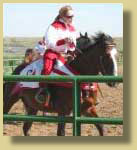
Hi, my name is Tasha Roe. I have a success story with a Mustang. I am currently in Westernaires located in Golden, CO. I ride with the team of the Crimson Rangers and have been riding the same Mustang for about 4 years now. He is a Westernaire owned horse but I treat him like he is my own. We have gone to various Westernaire shows together, including the Annual Show and also performing Tasha Roe with Blaze warming up for High School Rodeo in the High School Rodeo Finals with the Crimson Rangers team. I have had the opportunity to grow up with him over the years. I have also overcome a few obstacles with him. He has turned out to be one of the greatest horses I have ever ridden. His name is Blaze and he is about 8 years old now. I wish he was my own Mustang. One day I will be able to adopt my own.

Burro Love
We fell in love with burros years ago in Oatman, AZ. They would stick their heads in your car window for a carrot. We did some research and knew we wanted to adopt a donkey of our own one day.
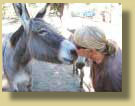
When my husband and I moved to "the country", where we would have space for a burro, I couldn't wait until we could adopt one.
We adopted our Lily in June 2005, at the Bureau of Land Management (BLM) adoption in Alpine, CA less than a year after moving to our new property. My husband and I spent hours upon hours with Lily in her corral; talking to her, reading, offering her carrots. It was a happy day 3 months later when she didn't move away when I attempted to pet her.

One month later we could halter her and it wasn't long before we could pick up her feet, plus she would stand for the farrier.
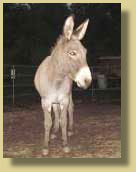
We began to notice she looked pregnant and our surprise baby, Vernon, was born Dec. 12, 2005. I was there to watch his birth. Lily trusted us and never minded us hugging or kissing the baby. We adore him and he is a little rascal, even at 2-1/2 years old.
Before Vernon was born, we were asked to take a male donkey, Wilbur, who had not been taken care of by the person who adopted him. His eyes had large ulcers from flies biting him. He was healed by our mentor, Dorian Avery-Brown, and brought to us in October 2005, four months after we adopted Lily.
Lily, Vernon, and Wilbur have bonded and are a wonderful little family. They have enriched our lives in many ways. We cannot imagine life without them. They are so gentle, sensitive and loving.

Mustangs Help Patrol U.S. - Mexico Border
With all the high tech efforts to safeguard the borders you might be surprised to learn old fashioned horse patrols are still quite effective. The mounted border patrol agents are beginning to ride mustangs on the Northern and Southern borders of the United States.
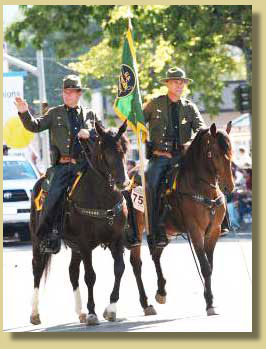
Mustangs are inherently strong and excel in endurance. They also have very few problems with their hooves and legs. Mustangs are basically the breed of "survival of the fittest"; Mother Nature at its best. It turns out this American breed brings special skills to the job, said the Border Patrol.
Tony is a 4 year old buckskin gelding from the Wyoming White Mountain herd management area. This picture was taken at the Santa Teresa Border Patrol Station in Santa Teresa, NM - El Paso sector.
This "symbol" of the Old West is a modern day member of the Border Patrol's mounted force. This breed is especially well adapted for the work they are required to do.
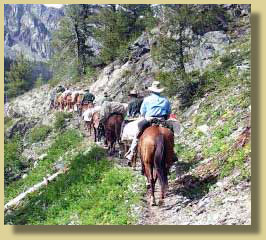
"All of our mustangs can move up a trail at a good pace. ATV's can't get up there. Trucks can't get up there." said Bobby Traweek, U.S. Border Patrol ranger. "They have a better immune system and better bone structure. They have larger hooves than your average domestic horse."
Mustangs run wild over the rugged terrain in ten western states. The Bureau of Land Management (BLM) is the government agency that is responsible for controlling the wild populations by gathering them from the public rangelands when an over-population exists and offering them to the general public to adopt. The BLM is mandated to ensure that no degradation of the range happens. They also have to monitor forage and water availability for the mustangs, wildlife and other users of the public ranges.
"We're lucky to have these two mustangs. It’s two more that have found good homes and excel at their work," said Traweek.
There are only a few mustangs working along the U.S. - Mexico Border Patrol, but the agency is hopeful it will be able to add more wild horses as it beefs up their mounted patrol units. Their wild past makes mustangs especially vigilant.
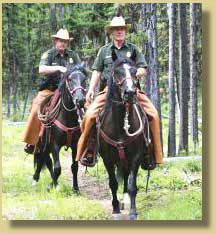
"They'll perk up their ears or they'll stop and alert the ranger when there are problems. It makes it a lot easier for us, said Jesus Arevalo, U.S. Border Patrol. "They may have a mountain lion chase them or a bear chase them, but due to their survival extinct, the mustang knows exactly how to respond."
The wild horses can sense a smuggler hiding in the brush or a person called a "border bandit."
In addition to all the other positives, the mustangs cost about half of what the Border Patrol is used to paying for horses that patrol the border.
At present, the Southern Border Patrol has four mustangs working on the U.S. - Mexico border in the El Paso and Del Rio area. Seventeen additional mustangs have been adopted to assist patrolling the Northern border of Canada. All of the mustangs were trained by inmates and staff at the Colorado Wild Horse Inmate Program.

A Dream Come True in Utah
Every now and then we are privileged to experience a “Dream Come True.” This is a story about Sam and his dream come true, a wild horse named “Spud.” I hope that it touches your heart as it did mine.
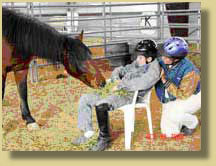
During the weekend of October 29, Intermountain Wild Horse and Burro Advisors (IWHBA) and the National Ability Center (NAC) in Park City, Utah hosted a “Communications 101 course – working with the horse’s spirit and mind to form a successful partnership” event. It was a two-day event that included a mini-adoption, hands-on gentling clinic and demonstrations. The event was promoted, organized and conducted by BLM volunteers with the exception of the mini-adoption.
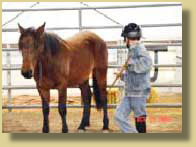
On Saturday morning, a young man named Sam showed up to participate in the Communications 101 course. After his parents signed a waiver for him to be in close contact with the Bureau of Land Management’s (BLM) wild horses and burros, Sam scoped out the three pens, each occupied with a young, ungentled, BLM freezebranded wild horse. After checking out each pen, Sam immediately walked up to Spud, a little bay gelding from the Saylor Creek Herd Management Area located outside of Boise, Idaho and declared that he wanted to work with him. Vickie Green, one of the experienced volunteers from IWHBA, assisted Sam in the pen, and coached him through the initial wild horse gentling process. By the end of the day, Sam was able to touch and pet Spud.
Sam’s family had not planned on attending both days of the clinic, however, Sam would not take no for an answer. So, the first thing Sunday morning, with his cowboy hat on, Sam walked in, ready to go back to work. He donned his helmet and got back in the pen with Spud. Before long, Vickie and Sam were able to get a halter on Spud. They began grooming him and picking up his feet. Sam and his Vickie from IWHBA began the process of teaching Spud to lead. Sam would ask and encourage Spud to take a few steps at a time, and then would go back and reward him. Ever so passionately he would say, “OK Spud, back to work.” And off they would go for a few more steps.

Sam’s Mom adopted Spud, this young ungentled 2 ½ year old BLM freezebranded wild horse. When Sam was ready to go home, so was Spud. Spud was able to be led into a horse trailer for the ride to his new home.
Some of you might say this is just another story about a young man who has the same dream as many, training their own wild horse. This isn’t just another story; this story is about a twelve-year old boy from Romania that was adopted when he was 2 ½ years old as well. To add to his challenges, Sam lost his right leg due to a freak accident when he was 4 years old. Doctors were forced to amputate his leg just above his knee.
Despite the obvious discomfort and insecurities a very young man of Romania faced living in America and our society, Sam was able to find a bonding spirit with Spud. With all of the trials and tribulations this young man has overcome, this is one special horse that has touched the life of one special young man. This is the kind of stuff “Dreams are made of.”

Adopted Wild Horses Honored for Endurance Achievements
America's wild horses have long been praised by their owners for their toughness, intelligence and endurance.
Now, two Northern California wild horses, and their owners and riders, have received national recognition from the American Endurance Ride Conference (AERC), the Bureau of Land Management (BLM) and the National Wild Horse and Burro Foundation for their excellence in endurance competition.
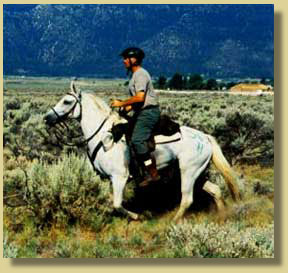
"BLM 2003 Endurance Wild Horse of the Year" awards were presented to Lincoln resident Ray Bailey and his horse "Sir Kai," and to Santa Cruz resident Dr. Philip Ottinger and his mount, "Robin Hood." Additionally, AERC honored Dr. Ottinger and Robin Hood for finishing first in the organization's West Region Featherweight Division in 2003.
The honors were presented Saturday, Feb. 28, during the American Endurance Ride Conference's annual awards banquet held in Reno.
Dr. Ottinger said time, patience and understanding in training have been the keys to his success in using wild horses in endurance competition.
"Once a wild horse connects with you, there is nothing he won't do for you," Ottinger said. "You have to take the time to understand how he thinks and to understand his physiology. You have to be open and clear about what you want."
Robin Hood, owned by Dr. Ottinger and currently ridden by Lincoln veterinarian Dr. Vicki Giles, was honored in the AERC's featherweight division. Dr. Ottinger adopted Robin Hood from the BLM in 1993, when he was just a yearling. Robin Hood finished 46th in his first endurance race in 1996. The following spring, he placed 10th in the 50-mile "Shine and Shine Only" race, and has continued to excel since then.
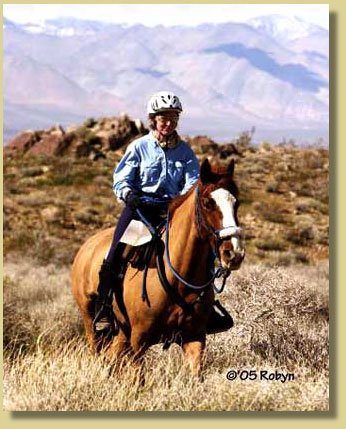
As of this February, Robin Hood has completed nearly 4,000 miles in endurance ride competition and placed in the top 10 in the majority of 78 endurance rides. He has received 14 "Best Condition" awards. Ridden by Dr. Giles, he ended the 2003 competition season as points champion in the AERC West Region Featherweight Division.
Sir Kai, currently ridden by Lincoln's Ray Bailey, also was originally adopted by Dr. Ottinger. Bailey acquired the titled three-year-old from Dr. Ottinger in 1997. Sir Kai placed ninth in his first limited-distance ride, the "Death Valley 25," in 1999. He followed that performance with a third place and best condition award in the Lake Oroville Vista LD ride. During the 2003 AERC National Championship Ride, Sir Kai and Bailey placed first in the heavyweight division of the 50-mile ride.
They placed eighth in their first 100-mile ride this February. Sir Kai has now completed more than 1,300 miles in endurance competition.
The BLM, AERC and the National Wild Horse Foundation joined as partners this year to sponsor endurance awards for wild horses.
The BLM is the federal agency responsible for managing wild horse and burro herds on public lands. Some wild horses are periodically removed from the range to control wild populations, and are made available for adoption by the public.
Supporting the adoption program is the National Wild Horse and Burro Foundation, a private, non-profit organization. It helps the BLM with promotion of the adoption program, to increase successful placement of wild horses in adoptive homes.
The AERC is the official sanctioning body for horse endurance competition in the United States.

Mustang Wins World Champion in Western Riding
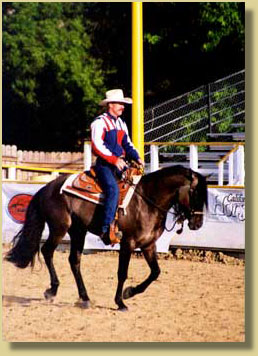
On July 25, 2002, the American Buckskin Registry Association (ABRA) awarded a wild horse, Steen's Vaquero, the World Championship in Western Riding, Open. Adopted and trained by Pam and Matt Fournier of Oregon, this talented young stallion, also known as "Cowboy," placed 3rd in the world for Trail, Junior Horse and English Pleasure, Open and 4th in Hunter Hack, Open.
Cowboy, a five-year-old mustang stallion, was adopted by the Fournier's in October 1999, "Cowboy" and Matt Fournierfrom the Bureau of Land Management's (BLM) Adopt a Wild Horse or Burro Program. The BLM, an agency of the Department of the Interior, is responsible for managing the nation's public lands. With the passage of the Wild Free-Roaming Horses and Burros Act of 1971, a responsibility of BLM is to preserve and protect wild horses and burros and to manage for healthy rangelands. When an overpopulation of wild horses and burros exists on the range, the excess animals are removed and offered to the general public for adoption.
Cowboys' accomplishments are quite extensive, Grand Champion Mustang Stallion, High Point Open Horse, and High Point Amateur Horse at the National Wild Horse and Burro Show, all within less than a year of being adopted. In 2001, he began competing in ABRA shows. In his first year, competing almost exclusively with Quarter horses, Cowboy placed second in the nation in first year green western pleasure and earned enough points for a Register of Merit in Western Pleasure. He has won more than ten trophy buckles, including the Central Oregon Buckskin Club ABRA.
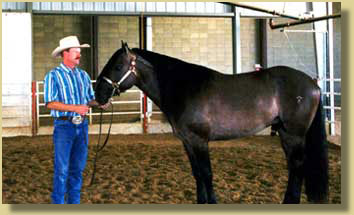
The Fournier's adopted Cowboy because of his size, color, and conformation. Cowboys features are typical for a wild horse; sturdy build, short back, good bone structure and excellent feet," said Pam Fournier. His broad forehead, noble profile and his large warm eyes are evidence of his intelligence that is so characteristic of the mustang."
Since 1993, the Fournier's have adopted more than twenty wild horses and burros and have found them to be excellent for ranch work, hunting, pleasure riding and show horse. After adopting and training wild horses and burros for almost ten years, Matt Fournier said, "Cowboy is one of the most talented horses I've ever ridden."

BLM mustangs on “The Fearful Crossing"
Dry, dusty, with no potable water and very little game, “The Forty Mile Desert” was the most deadly and feared stretch of the Old California Trail. Historians estimate that for every 17 feet of this 65-mile stretch of trail, there is one buried human, horse, mule, or ox. (It is called the Forty Mile Desert, but the trail through it is 65 miles).
“The Fearful Crossing” wagon train and trail ride, organized by Bill Adams and Kathy Davis from Fallon, Nevada, aims to re-enact (without the death and starvation part!) the Westward Migration experience. The group this year consisted of six wagons pulled by mules or draft horses, and 36 people, either riding in wagons or riding their own horses or mules. The trek is almost entirely over BLM land, except for the last couple of miles through Fallon.
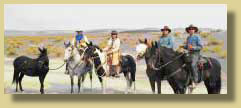
This year, four adopted BLM mustangs participated in the event. Mike and Nancy Kerson of Napa, California, rode their mustangs Ruby, from California’s Twin Peaks herd management area (HMA), and Sparky (from Nevada’s Calico Mountains HMA), and Mike ponied their daughter’s young half-mustang mule, Eleanor. Petra Keller of Reno, Nevada, rode Charlie (a mare born at the National Wild Horse and Burro Center at Palomino Valley), and Dave Frazier of Paradise, California, rode his large dark bay from the Tonopah area, named – what else? – Tonopah. All four were barefoot, and all four completed the trip 100% sound, and with energy to spare.
Since lack of food and water was the thing that killed the pioneers, this group was safe, because water and food were delivered at lunch time, and a truck brought in big water tanks and hay at night (we even had a shower as well as a caterer!), so the trip was less “fearful” than for the pioneers.
But it was certainly awesome! It was also humbling, to think of those poor pioneers who struggled across it without water, with very little food, and no end in sight. The most “fearful” part for Nancy was Day Three, when the trail followed along Highway 95 next to the Union Pacific railroad tracks. Sparky did not like trains, especially long ones!
The desert landscape was varied and incredibly beautiful. It’s BIG out there! Vegetation ranged from salt grasses along the sinks to a variety of tough, prickly bushes – no trees, no shade anywhere. The trail ranged from easy hard-packed dirt or gravel to one stretch of truly nasty shale and sharp rocks through the willows, to deep sand dunes that required the horses to bunny hop, to crunchy, crusty alkali flats. The latter was sort of like walking on snow that has melted and re-frozen a few times. You go along fine until all of a sudden your horse steps through the crust and falls down a few inches. It kept things interesting. The terrain was mostly flat, though we did go over a few hilly passes.
Our mustangs did so well – they hardly even broke a sweat. I gained a new appreciation of just what these horses are made of. I was worried that it might be too much for them. Ha! Not to Worry!
The last day we saw a band of riders coming toward us from another trail at full gallop, dust rising behind them – just like a Wild West movie. Luckily, instead of bandits, it was a group of friendly local horse and mule riders, who came to join us for the last few miles. One of those riders had a branded BLM mustang as well - unfortunately I did not catch her name.
Riding into Fallon on Sunday afternoon, we had mixed feelings: On the one hand, we felt absolute exhilaration that we had made it. On the other hand, sadness that it was over, and we would soon be back to our ordinary lives. At the trailers, a car alarm went off - a fitting signal that we were undeniably back in the 21st century.
Our Mustangs took great care of us, and all four of us remarked to each other how privileged we felt to be part of “The Mustang Club.”
Bill Adams and Kathy Davis have been operating this wagon train for 13 years. They can be reached at (775) 867-3590 for more info about their wagon trains.
